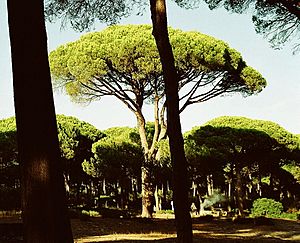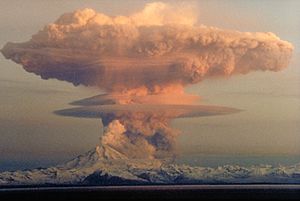Plinian eruption facts for kids
A Plinian eruption is a very powerful type of volcanic eruption. It is named after Pliny the Younger. He wrote the only eyewitness story of the famous AD 79 eruption of Mount Vesuvius. This eruption was so strong that it killed Pliny the Younger's uncle, Pliny the Elder.
Plinian eruptions shoot huge columns of gas and volcanic ash very high into the sky. These columns can reach the stratosphere, which is a layer of Earth's atmosphere. A lot of light, spongy rock called pumice is also thrown out. These eruptions are known for their incredibly strong blasts of gas.
Short Plinian eruptions can be over in less than a day. Longer ones can last for several days or even months. They often start with big clouds of volcanic ash. Sometimes, they also produce fast-moving flows of hot gas and rock called pyroclastic flows. If a huge amount of magma erupts, the top of the volcano can collapse. This leaves a large bowl-shaped hollow called a caldera. Fine ash from these eruptions can cover very large areas. Plinian eruptions are often very loud, like the famous 1883 eruption of Krakatoa.
Contents
Famous Plinian Eruptions Around the World
Many large Plinian eruptions have happened throughout history. They often create calderas. Here are some examples:
- The 1991 eruption of Mount Pinatubo in Luzon, Philippines.
- The 1980 eruption of Mount St. Helens in the United States.
- The 1883 eruption of Krakatoa in Indonesia.
- The 1815 eruption of Mount Tambora, also in Indonesia.
- The 1667 and 1739 eruptions of Mount Tarumae in Japan.
- The 1645 BC eruption that formed the Santorini caldera in Greece.
- The 4860 BC eruption that created Crater Lake in the United States.
- The eruption that formed the Long Valley Caldera in eastern California over 760,000 years ago.
- And, of course, the AD 79 eruption of Mount Vesuvius. This eruption is the perfect example of a Plinian eruption.
The molten rock, or lava, from Plinian eruptions is usually rhyolitic. This means it has a lot of silicates. It is rare for Plinian eruptions to have basaltic lava. The 1886 eruption of Mount Tarawera was one of the few exceptions.
Pliny the Younger's Story of Vesuvius


Pliny the Younger wrote about what his uncle, Pliny the Elder, did when he first saw the eruption. Here is part of his famous letter:
On August 24th, around one in the afternoon, my mother asked him to look at a cloud. It was very unusual in size and shape. My uncle had just finished his walk and bath, eaten a light lunch, and gone back to his books. He immediately got up and went to a higher spot to get a better view of this strange sight. A cloud was rising from a mountain (we later found out it was Mount Vesuvius). I can best describe it by comparing it to a pine tree. It shot up very high like a tall trunk, then spread out at the top like branches. I think this happened either because a sudden gust of air pushed it, and its force lessened as it went higher, or because the cloud itself was pushed back by its own weight and spread out. It looked bright sometimes and dark and spotted at other times, depending on how much earth and ash it contained. To a man as learned as my uncle, this event seemed extraordinary and worth investigating further.
– Sixth Book of Letters, Letter 16
Pliny the Elder bravely sailed across the Gulf of Naples to Stabiae (near modern Castellammare di Stabia). He wanted to rescue people caught in the eruption. Pliny the Younger wrote that his uncle collapsed and died from breathing in the volcano's poisonous gases. His body was found on August 26th, after the ash cloud had cleared. He had no visible injuries, which supported the idea that he died from suffocation or poisoning.
Related Topics
See also
 In Spanish: Erupción pliniana para niños
In Spanish: Erupción pliniana para niños


